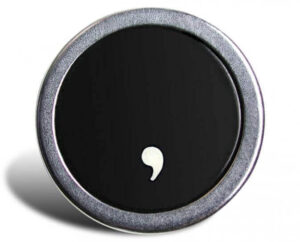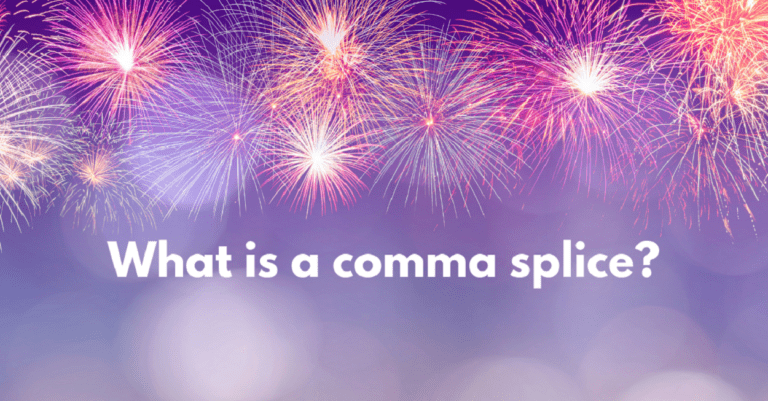I decided to write about comma splices because my friend Scott Sigler has a book coming out this week, Ancestor, published by Crown. Over three years ago, when he was publishing an earlier version of the book with a smaller publisher, he asked me to read it for him and be as brutal as possible with my comments. The biggest problem I found was comma splices.
How to Use Commas
Commas are tricky because there are so many different ways you can use them, but one of the most common ways to use commas is to separate two main clauses that are connected by a coordinating conjunction. That just means that when you join two things that could be sentences on their own with a word such as “and,” “but,” or “or,” you need a comma before the conjunction:
Squiggly ran to the forest, and Aardvark chased the peeves.
Squiggly ran to the forest is a complete sentence, and Aardvark chased the peeves is also a complete sentence. To join them with a comma, you need the word “and” or some other coordinating conjunction. If you just put a comma between them, that’s an error called a comma splice or a comma fault:
Squiggly ran to the forest, Aardvark chased the peeves. (wrong)
What Is a Comma Splice?
Comma splices seem to be Scott Sigler’s biggest problem. Here’s an example from page 114 of the original Ancestor book, where one of the characters is talking about a cow named Fonzie:
Sara obviously named that one, she was a sucker for those old “Happy Days” reruns. (wrong)
It’s easy to see in that example why the error is called a comma splice: it’s because the comma is used to splice together two complete sentences when that isn’t the function of a comma.
Commas aren’t meant to join main clauses all by themselves; to force them into that role is to perpetrate a comma splice.
The good news is that it’s easy to fix a comma splice once you’re aware of the problem. Because the two clauses are complete sentences, you can treat them that way and use a period where you had a comma.
Sara obviously named that one. She was a sucker for those old “Happy Days” reruns.
It’s a period’s job to separate complete sentences.
How to Use a Semicolon to Fix a Comma Splice
If the two sentences are closely related to each other, as they are in the sentence from Ancestor, you can use a semicolon to connect them without a coordinating conjunction.
Sara obviously named that one; she was a sucker for those old “Happy Days” reruns.
The semicolon makes sense because the second clause expands on the reasoning of the first clause. He’s saying that it’s obvious that Sara named the cow because she liked “Happy Days” reruns and the cow is named after a “Happy Days” character. (Want more? See Episode 189, How to Use Semicolons.)
You can think of a semicolon as a “sentence splicer” because its job is to splice complete sentences together.
How to Use Coordinating Conjunctions to Fix a Comma Splice
Sometimes, you can also fix a comma splice by adding a coordinating conjunction. It doesn’t work with the example sentence from Ancestor because it doesn’t make any sense to add an “and” or any of the other coordinating conjunctions. It changes the meaning to say Sara obviously named that one, and she was a sucker for those old “Happy Days” reruns.
But if I go back to the other sentence with a comma splice—Squiggly ran to the forest, Aardvark chased the peeves—you can see that it makes sense to connect those two sentences with a coordinating conjunction and a comma.
Squiggly ran to the forest, and Aardvark chased the peeves.
More Comma Splice Examples
Let’s take one more of Scott’s mangled sentences and see if we can fix it!
This one is from page 29, where he’s explaining how one of the characters lured in investors for his evil plan.
They were getting it, he had them. (wrong)
So in the comma splice repair kit, we’ve got periods, semicolons, and coordinating conjunctions. (See Episode 122: Is “Have Got” Acceptable English?)
The period definitely works: They were getting it. He had them.
The semicolon works because the two clauses are related: They were getting it; he had them.
And in this case we can add a coordinating conjunction to fix the problem too: They were getting it, and he had them.
Comma Splice Summary
So, I hope you get it! Commas aren’t meant to join main clauses all by themselves; to force them into that role is to perpetrate a comma splice. That’s bad, but it’s easy to fix.
You, Sir, Are no Cormac McCarthy

The change highlights an interesting point about punctuation and writing in general that sometimes comes up. People will argue that authors should be allowed to make stylistic choices about writing and include comma splices or whatever quirks they want as a matter of art. They’ll point to best-sellers such as E. E. Cummings who used all lowercase letters or Cormac McCarthy who is known to use as little punctuation as possible, often avoiding commas, apostrophes and quotation marks.
Occasionally, someone brilliant intentionally bucks the rules and still succeeds, but it’s much more common for writers to have consistent errors like comma splices in their manuscripts not because they are brilliant renegades, but because they actually don’t know the rules.
I’ve talked to many editors who do look at the grammar and usage in manuscripts and don’t look kindly on errors. Unless you want to make it more difficult to get your ideas across to editors and readers, stick with traditional punctuation.
Ancestor
If you’d like to pick up Scott Sigler’s book, Ancestor—the story of an attempt to create universally transplantable organs gone horribly wrong—it’s available now, online and in bookstores across the United States.
Web Bonus
Here are some other ways to fix a comma splice.
Make one of the main clauses a subordinating clause:
Squiggly ran, Aardvark hid. (wrong)
Because Squiggly ran, Aardvark hid. (right)
You can read more about subordinating conjunctions in Episode 221, ‘Although’ Versus ‘While,’ and the tip Can You Start a Sentence with “Because”?
Make one of the main clauses a phrase:
Aardvarks are the most noble nocturnal animal, they free us from ants. (wrong)
Aardvarks—the most noble nocturnal animal—free us from ants. (right)
There are rare specific cases where it is acceptable to join complete sentences using just a comma. Yes, I just said comma splices are allowed in some cases. For example, the authors of the grammar handbook Things Your Grammar Never Told You say it is acceptable to use commas to join very short sentences that are exactly parallel: I came, I saw, I conquered. Strunk & White give similar advice in The Elements of Style. Proceed with caution.
Exercises
- Fix the comma splices in the following sentences. Use each of the following at least once: a semicolon, a coordinating conjunction, a period, and a subordinating conjunction.
- 1. Mix ginger and lime with water, it makes a tasty and refreshing drink.
2. I wonder where Herbert went, he should have been back by now.
3. Cooper swam 15 laps, he won’t be able to do that again tomorrow.
4. We went to the store, we wanted to buy some chips.
Typewriter Comma Key image from Shutterstock




